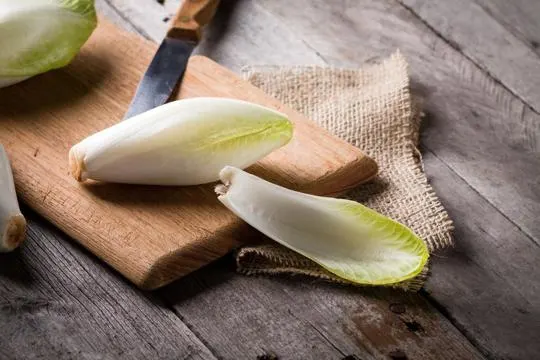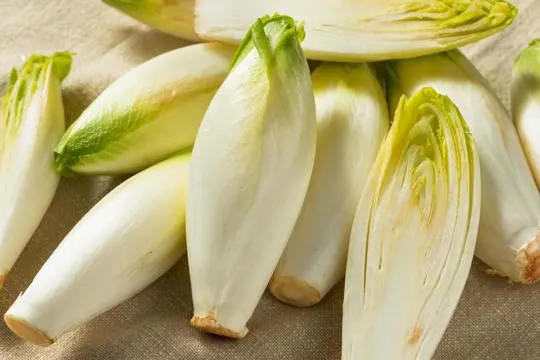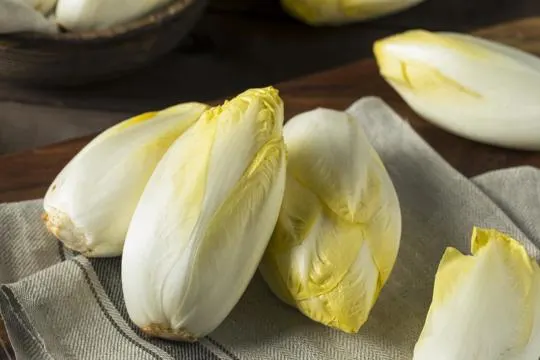Endive and Belgian Endive may sound like distant cousins at a family reunion, right? But here’s the twist: they’re more like siblings with a quirky secret. We’re here to spill the beans on this leafy mystery.
Believe it or not, we’ve all been there. Staring at the greens section, scratching our heads. “Is this the fancy one or its down-to-earth sibling?” we whisper.
Our kitchens have seen both. The mix-ups. The accidental stars of a dish meant for the other. It’s a comedy of errors—kitchen edition.
Stay tuned as we dig into the roots of this green enigma, armed with nothing but wit and vegetable peelers. It’s going to be a crunchy ride.
What is Endive?

Endive, a lesser-known leafy green, is a mystery to many.
With a slightly bitter taste and curly leaves, it’s often mistaken for lettuce or even kale.
But make no mistake, endive is a unique and delicious addition to any dish.
There are two main types of endive: curly endive and Belgian endive.
Curly endive, also known as frisée, is typically used in salads due to its crispy texture and sharp taste.
Belgian endive, on the other hand, is a smaller, more compact variety that is often used in appetizers or as a garnish.
But what truly sets endive apart is its nutritional value.
Packed with vitamins and minerals such as vitamin A, vitamin K, and folate, endive is a superfood that should not be overlooked.
So next time you’re looking to mix up your greens, give endive a try – you won’t be disappointed.
What is Belgian Endive?

Belgian endive is a special cultivar of endive.
It’s known for its white leaves and crunchy texture.
Plus, it has a slightly bitter, nutty flavor, making it great for salads or a snack.
Growing the endive in darkness is called “forcing”.
This takes 3 weeks.
These vegetables are versatile.
Enjoy them raw, cooked, steamed, or grilled.
They contain vitamins A and K, plus have health benefits.
Low in calories and high in fiber, they’re great for those trying to lose or maintain weight.
Belgian endives have an interesting history.
In the 19th century, they were discovered by accident when a farmer in Belgium hid his chicory roots from the light.
This led to the creation of this unique veggie.
Try Belgian endives.
They offer something for everyone.
Get them at the grocery store and enjoy the flavors they bring.
Differences Between Endive and Belgian Endive

Endive and Belgian endive are easily mixed up.
But, they have differences in flavor, texture, and looks.
Knowing their differences can make your meals and nutrition better.
1 – Appearance and Shape
Endive and Belgian endive are often confused.
Though, they look and are shaped differently.
Endive has long leaves with curly edges which come in both green and red.
Whereas, Belgian endive has a tight head and is either white or light yellow.
Endive grows outside but Belgian endive is grown indoors in dark places.
Belgian endive is not exposed to sunlight which makes it mild and pale.
Endive, on the other hand, gets darker as it matures.
The taste also varies due to different growing conditions.
Belgian endives have small leafy plants.
Generally, they reach up to 6 inches tall.
The leaves are lobed or toothed with deep green color.
Frisee looks like chicory but has thin stems and long leaves that are finely cut at the ends.
Perfect for salads.
2 – Cultivation and Growing Methods
Endive and Belgian endive need different growing practices.
Endive is cultivated outdoors, but Belgian endive is grown indoors.
To make Belgian endive, it must be harvested twice.
The second time, the roots are kept in the dark for a few weeks to cause new leaves to appear.
Both require certain soil conditions.
Plus, Belgian endive needs more managed environmental elements like lighting and humidity.
Knowing these differences is key for successful growing of both veggies.
3 – Flavor and Texture
Endive and Belgian Endive are often confusing.
They both belong to the chicory family, but have dissimilar flavor and texture.
Belgian Endive has a mild nutty taste with a bitter aftertaste.
Its texture is crisp and firm – great for salads or as crudite.
Endives, on the other hand, have a more robust taste – with sweet and bitter hints.
Its texture is crunchy and sturdy.
Beyond their flavor and texture, their culinary applications also differ.
Belgian Endive is very versatile – it can be eaten raw or cooked.
Grill, sauté, or roast with butter to bring out its natural sugars.
Endives are resilient when cooked – they don’t lose their crunch even with long cook times.
Great for soups or stews.
Similarities Between Endive and Belgian Endive

Endive and Belgian endive are two kinds of leafy veggies with many similarities.
They are part of the Chicory family and have great health benefits.
Leaves of both are shaped similarly and have a slight bitter taste.
They can be eaten raw or cooked.
Salads, soups, and stews are recipes which can use either interchangeably.
Though, there are some differences to note.
Endives are generally grown outside, having green-tipped leaves due to light exposure.
Meanwhile, Belgian endives are grown indoors, resulting in a milder flavor and white-tipped leaves.
Additionally, they can be pricier due to the controlled environment they grow in.
Besides, both types of endive provide essential nutrients such as vitamin K, folate, and antioxidants.
Plus, they add a crunchy bite to meals.
Choosing which one is up to personal taste or what a recipe requires.
Culinary Uses of Endive and Belgian Endive
Endive and Belgian Endive may look alike, yet they are two different veggies with diverse culinary uses.
Endive is generally used in salads for its bitter flavor and crunchy texture.
While Belgian Endive is typically cooked, like braised, grilled or roasted to bring out its delicate sweetness.
Endive can be a low-carb alternative for bread and can hold dips or fillings.
Belgian Endive leaves are great for starters and can be stuffed with cheese, meats, fruits and other savory items.
Both Endives are awesome ingredients for soups, stews, casseroles and side dishes.
It’s noteworthy that Belgian Endive is known as Chicory in Europe and it’s not the same as American-Grown Chicory with different characteristics and purposes.
Because of their exclusive flavors and textures, Endives are growing in popularity in various cuisines worldwide.
These underrated veggies have high amounts of fiber, vitamins A & C, folate and potassium which adds nutritional value to the dish.
When buying, pick plump heads with tightly packed leaves with no signs of wilting or blemishes.
Refrigerate separately from fruits like apples since juices can soften the leaves if stored together.
Both endive varieties deliver a flavorful punch that’s worth exploring in your cooking.
From salads to main dishes or appetizers to side dishes endives offer something for everyone.
Nutritional Differences between Endive and Belgian Endive
Endive and Belgian endive look the same, but they are not.
Endive has a leafy green veg with serrated edges plus a bitter taste.
Belgian endive has thicker leaves, a crunchy texture and a nutty flavor.
Even though these veggies are related, they have different nutritional values.
For example, one cup of chopped endive has 17 calories and is high in Vitamin K.
A similar amount of Belgian endive contains 8 calories and loads of Vitamin A.
Endives have fibers and minerals such as iron, calcium, and phosphorus for healthier bones, hair, and skin.
Belgian endives contain calcium to help muscle contraction.
Interesting fact: endives are grown outdoors while Belgian endives have no sunlight – indoors.
Knowing the differences can help you make better dietary decisions.
Where to Buy Endive and Belgian Endive?
Endive and Belgian endive can be found in many places.
Here’s where:
- Check the produce section of your local supermarket. You’ll find them near other leafy greens like lettuce and spinach.
- Head to a farmer’s market or specialty store for a wider selection. Curly endive, escarole, and more.
- Look for Belgian endive in gourmet stores or high-end supermarkets. They come as single pieces or in small packs.
- Buy them online from specialty retailers or delivery services.
Trying endive is a great way to add something unique to salads and dishes.
Belgian endive is also great for cooked recipes like gratins and stews.
So, keep an eye out for recipes incorporating these yummy veggies.
Conclusion
Endive and Belgian endive can be easily mistaken.
But they are very different. Endives are leafy and bitter.
Belgian endives are sweet and have a tight head. Endives grow in soil.
Whereas, Belgian endive is cultivated in hydroponic conditions.
Surprisingly, both offer health benefits.
Endives are full of antioxidants, fiber, and vitamins A and K.
Belgian endives provide Vitamin C, potassium, folate, and fiber.

Leave a comment